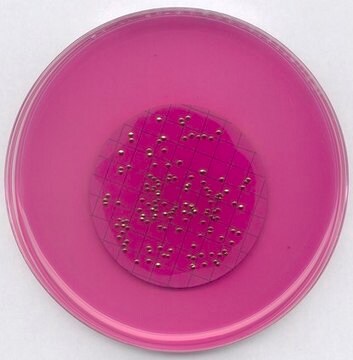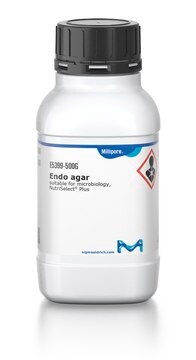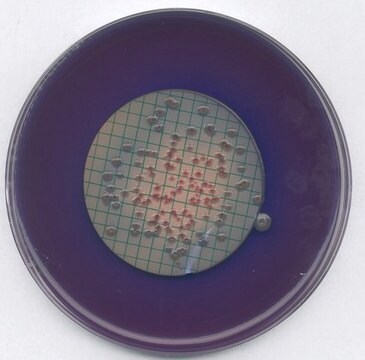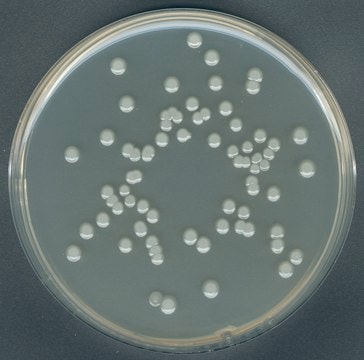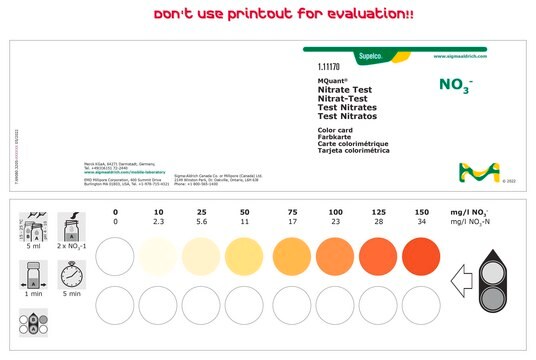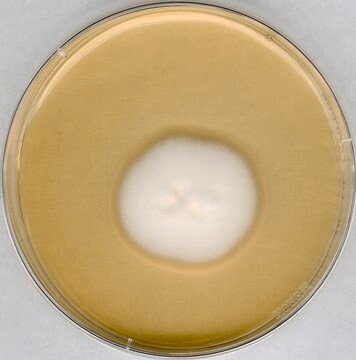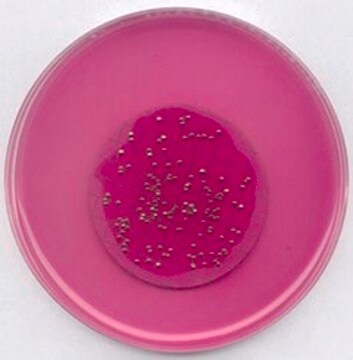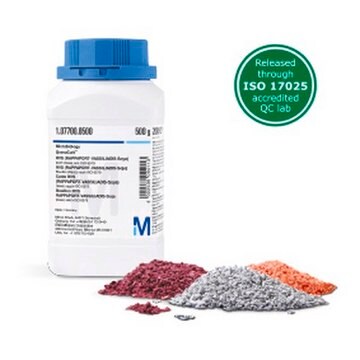1.04044
GranuCult® ENDO agar
for Escherichia coli, for coliforms, suitable for microbiology
Synonym(s):
Coliform selective medium, Endo C agar, Fuchsin lactose agar acc. to ENDO
About This Item
Recommended Products
Agency
according to ENDO
Quality Level
sterility
non-sterile
form
granular
packaging
pkg of 500 g
manufacturer/tradename
GranuCult® plus
technique(s)
microbiological culture: suitable
color
red-violet
pH
7.2-7.6 (37 °C, 39 g/L in H2O, after autoclaving)
solubility
39 g/L
bulk density
700 kg/m3
application(s)
food and beverages
microbiology
storage temp.
15-25°C
suitability
Escherichia coli
coliforms
Related Categories
General description
Application
Features and Benefits
- GranuCult® offers superior granulated culture media.
- Safe and sustainable due to reduced risks associated with fine dust and toxic substance inhalation, resulting in a safer work environment.
- Excellent wettability, solubility, and free-flowing properties
- Convenient, with minimal component separation and clumping, even under warm or humid conditions.
- High batch-to-batch reproducibility
- Prolonged shelf life of up to five years
- High number of test strains exceeding all regulatory demands
- Granulation technology allows many supplements to be included, with no need to add these separately
Storage and Stability
Analysis Note
Appearance (colour): pink/red
pH-value (25 °C): 7.2 - 7.6
Growth (Escherichia coli ATCC 25922 (WDCM 00013)): good to very good
Growth (Escherichia coli 194): good to very good
Growth (Escherichia coli ATCC 11775 (WDCM 00090)): good to very good
Growth (Enterobacter cloacae ATCC 13047 (WDCM 00083)): good to very good
Growth (Klebsiella pneumoniae ATCC 13883 (WDCM 00097)): good to very good
Growth (Salmonella typhimurium ATCC 14028 (WDCM 00031)): good to very good
Growth (Shigella flexneri ATCC 12022 (WDCM 00126)): good to very good
Growth (Proteus mirabilis ATCC 14153): good to very good
Growth (Enterococcus faecalis ATCC 11700): none to fair
Red colonies (Escherichia coli ATCC 25922 (WDCM 00013)): +
Red colonies (Escherichia coli 194): +
Red colonies (Escherichia coli ATCC 11775 (WDCM 00090)): +
Red colonies (Enterobacter cloacae ATCC 13047 (WDCM 00083)): +(poor)
Red colonies (Klebsiella pneumoniae ATCC 13883 (WDCM 00097)): +
Red colonies (Salmonella typhimurium ATCC 14028 (WDCM 00031)): -
Red colonies (Shigella flexneri ATCC 12022 (WDCM 00126)): -
Red colonies (Proteus mirabilis ATCC 14153): -
Metallic lustre (Escherichia coli ATCC 25922 (WDCM 00013)): +
Metallic lustre (Escherichia coli 194): +
Metallic lustre (Escherichia coli ATCC 11775 (WDCM 00090)): +(poor)
Metallic lustre (Enterobacter cloacae ATCC 13047 (WDCM 00083)): - or poor
Metallic lustre (Klebsiella pneumoniae ATCC 13883 (WDCM 00097)): -
Metallic lustre (Salmonella typhimurium ATCC 14028 (WDCM 00031)): -
Metallic lustre (Shigella flexneri ATCC 12022 (WDCM 00126)): -
Metallic lustre (Proteus mirabilis ATCC 14153): -
Incubation: 24 hrs. 35 °C
Other Notes
- The plates are clear and pale pink.
- If the culture medium is somewhat red after it has solidified, the red coloration can be removed by adding a few drops (max. 1 mL/liter) of a freshly prepared 10 % sodium sulfite solution and then boiling.
- On exposure to oxygen, the plated culture medium gradually becomes red due to the oxidation of sulfite and can thus no longer be used. It can only be kept for a few days even if it is stored in the dark and at refrigerator temperature.
Footnote
The designations basic, plus, or prime are added to indicate the quality control level, from basic quality control to standard QC plus to prime for full regulatory compliance.
Legal Information
recommended
Signal Word
Danger
Hazard Statements
Precautionary Statements
Hazard Classifications
Carc. 1B
Storage Class Code
6.1C - Combustible, acute toxic Cat.3 / toxic compounds or compounds which causing chronic effects
WGK
WGK 3
Certificates of Analysis (COA)
Search for Certificates of Analysis (COA) by entering the products Lot/Batch Number. Lot and Batch Numbers can be found on a product’s label following the words ‘Lot’ or ‘Batch’.
Already Own This Product?
Find documentation for the products that you have recently purchased in the Document Library.
Our team of scientists has experience in all areas of research including Life Science, Material Science, Chemical Synthesis, Chromatography, Analytical and many others.
Contact Technical Service